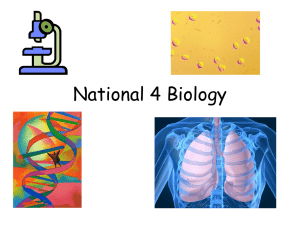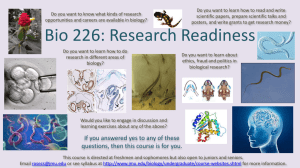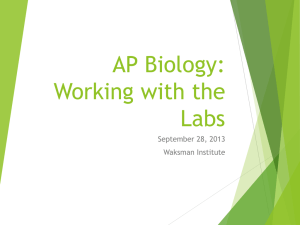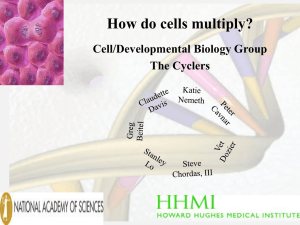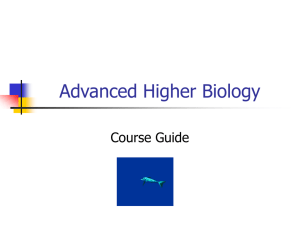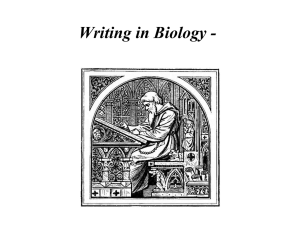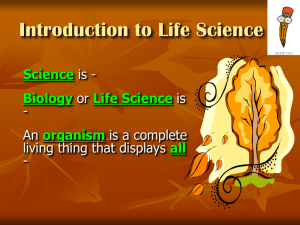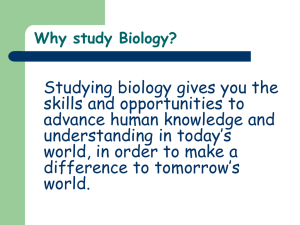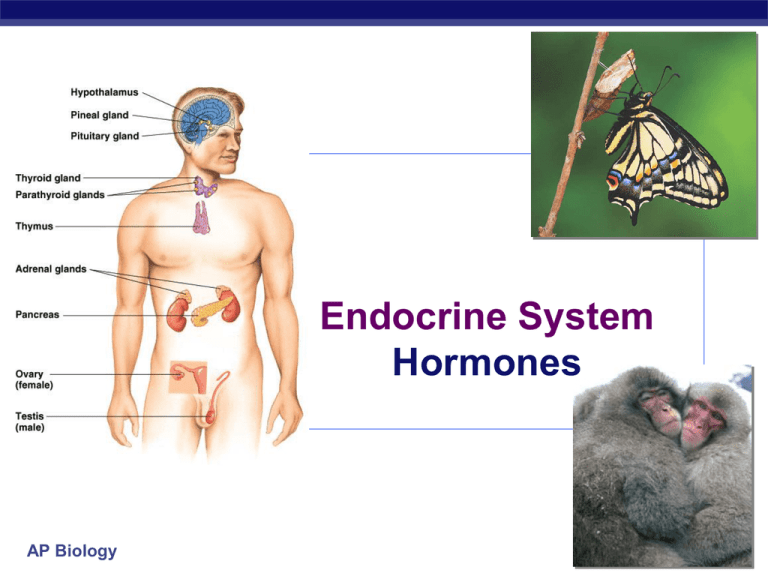
Endocrine System
Hormones
AP Biology
2006-2007
Regulation
Why are hormones needed?
chemical messages from one
body part to another
communication needed to
coordinate whole body
homeostasis & regulation
metabolism
growth
development
maturation
reproduction
AP Biology
growth hormones
Regulation & Communication
Animals rely on 2 systems for regulation
endocrine system
ductless gland which secrete
chemical signals directly into blood
chemical travels to target tissue
slow, long-lasting response
nervous system
system of neurons, central
nerve system
transmits “electrical” signal to
target tissue
fast, short-lasting response
AP Biology
Regulation by chemical messengers
Neurotransmitters released by neurons
Hormones release by endocrine glands
Endocrine gland
Neurotransmitter
Axon
Hormone carried
by blood
Receptor proteins
AP Biology
Receptor proteins
Target cell
Classes of Hormones
Protein-based hormones
polypeptides
small proteins: insulin, ADH
glycoproteins
large proteins + carbohydrate: FSH, LH
amines
modified amino acids: epinephrine, melatonin
Lipid-based hormones
steroids
modified cholesterol: sex hormones, aldosterone
AP Biology
How do hormones act on target cells
Lipid-based hormones
hydrophobic & lipid-soluble
diffuse across membrane & enter cells
bind to receptor proteins in cytoplasm & nucleus
bind to DNA as transcription factors
Protein-based hormones
hydrophilic & not lipid soluble
can’t diffuse across membrane
trigger secondary messenger pathway
activate cellular response
enzyme action, uptake or secretion of molecules…
AP Biology
Action of lipid (steroid) hormones
cytoplasm
steroid hormone
S
S
S
1
2
blood
protein
carrier
receptor protein
4
S
3
DNA
nucleus
AP Biology
mRNA
5 protein
plasma membrane
Action of protein hormones
1
Protein
hormone
activates
enzyme
G protein
cAMP
Receptor
protein
3
2
ATP
GTP
activates
enzyme
activates
enzyme
cytoplasm
AP Biology
4
Produces an action
protein
messenger
cascade
Action of epinephrine (adrenalin)
liver cell
1
epinephrine
activates
adenylyl cyclase adrenal gland
G protein
cAMP
receptor
protein
2
3
ATP
GTP
activates
protein kinase-A
activates
phosphorylase
4
cytoplasm
AP Biology
glycogen
glucose
released
to blood
Benefits of a 2° messenger system
1
Signal molecule
Receptor protein
Activated adenylyl cyclase
Not yet
activated
2 Amplification
4 Amplification
3
GTP
cAMP
5
G protein
Protein kinase
6 Amplification
Amplification!
AP Biology
Enzyme
7 Amplification
Enzymatic product
Negative Feedback Model
hormone 1
lowers
body condition
gland
high
specific body condition
low
raises
body condition
AP Biology
gland
hormone 2
2005-2006
Nervous System Control
Body Temperature
Feedback
nerve signals
brain
sweat
dilates surface
blood vessels
high
body temperature
low
brain
constricts surface shiver
blood vessels
AP Biology
nerve signals
2005-2006
Endocrine System Control
Blood Sugar
Feedback
insulin
liver stores
sugar
body
cells take
up sugar
from blood
pancreas
high
reduces
appetite
liver
blood sugar level
low
triggers
hunger
AP Biology
liver
releases
sugar
liver
pancreas
glucagon
2005-2006
Endocrine System Control
Blood Osmolarity
Feedback
ADH
increased
water
reabsorption
pituitary
increase
thirst
nephron
high
blood osmolarity
blood pressure
adrenal
gland
low
increased
water & salt
reabsorption
nephron
renin
aldosterone
AP Biology
angiotensinogen
angiotensin
2005-2006
Endocrine & Nervous system links
Hypothalamus = “master control center”
nervous system
receives information from nerves around body
about internal conditions
regulates release of hormones from pituitary
Pituitary gland = “master gland”
AP Biology
endocrine system
secretes broad range
of hormones
regulating other
glands
Hypothalamus
Thyroid-stimulating
Antidiuretic
Hormone
Posterior
hormone
(TSH)
pituitary (ADH)
Thyroid gland
Anterior
pituitary
Kidney
tubules
Muscles
of uterus
Adrenal
cortex
Gonadotropic
hormones:
Folliclestimulating
hormone (FSH)
& luteinizing
hormone (LH)
Melanocyte
in amphibian
Bone
and muscle
AP Biology
Testis
Ovary
Mammary
glands
in mammals
Homology in hormones
What does this tell you about these hormones?
same gene family
prolactin
mammals
milk
production
AP Biology
birds
fat
metabolism
fish
amphibians
salt &
water
balance
metamorphosis
& maturation
growth
hormone
growth
& development
Regulating metabolism
Hypothalamus
TRH = TSH-releasing hormone
Anterior Pituitary
TSH = thyroid stimulating hormone
Thyroid
produces thyroxine hormones
metabolism & development
AP Biology
bone growth
mental development
metabolic use of energy
blood pressure & heart rate
muscle tone
digestion
reproduction
tyrosine
iodine
thyroxine
Goiter
Iodine deficiency
causes thyroid to
enlarge as it tries to
produce thyroxine
AP Biology
Regulating blood calcium levels
Thyroid
Low blood Ca++
–
Negative
feedback
Increased absorption
of Ca++ from intestine
due to PTH activation
of Vitamin D
AP Biology
Parathyroids
Parathyroid
hormone (PTH)
Reabsorption of Ca++ &
excretion of PO4
Increased blood Ca++
Osteoclasts
dissolve CaPO4
crystals in
bone, releasing
Ca++
Feedback
Female reproductive cycle
egg
matures &
is released
(ovulation)
estrogen
builds up
uterus lining
corpus
luteum
ovary
progesterone
FSH & LH
maintains
uterus lining
fertilized egg
(zygote)
HCG
yes
pituitary
gland
pregnancy
GnRH
AP Biology
hypothalamus
no
corpus luteum breaks down
progesterone drops
menstruation
corpus
luteum
progesterone
maintains
2005-2006
uterus lining
Any Questions??
AP Biology
2005-2006
Animal Reproduction
&
Development
AP Biology
2005-2006
Oogenesis
What is the advantage
of this development
system?
Meiosis 1 completed
during egg maturation
ovulation
Meiosis 2 completed
triggered by fertilization
AP Biology
2005-2006
Fertilization
AP Biology
2005-2006
Fertilization
Joining of sperm & egg
AP Biology
sperm head enters egg
2005-2006
Cleavage
Repeated mitotic divisions of zygote
1st step to becoming multicellular
unequal divisions establishes body plan
different cells receive different portions of egg
cytoplasm & therefore different regulatory signals
AP Biology
2005-2006
Cleavage
zygote morula blastula
AP Biology
establishes future development
2005-2006
gastrulation in
primitive chordates
Gastrulation
Establish 3 cell layers
ectoderm
outer body tissues
skin, nails, teeth, nerves
ectoderm
mesoderm
blood, bone & muscle
mesoderm
endoderm
inner lining
digestive system
AP Biology
protostome
vs. deuterostome
endoderm
2005-2006
Neurulation
1st organ to form is notochord &
nerve chord
develop into nervous system
Neural groove
Neural tube
Notochord
AP Biology
2005-2006
Organogenesis
Mammalian embryo
Umbilical blood vessels
Chorion
Bird embryo
Amnion
Yolk
sac
Allantois
Fetal blood vessels
Placenta
AP Biology
Maternal blood vessels
2005-2006
Placenta
Materials exchange across membranes
AP Biology
2005-2006
Human fetal development
4 weeks
AP Biology
7 weeks
2005-2006
Sex determination
Sperm
Ovum
Y
Zygote
XY
X
SRY
Indifferent
gonads
No SRY
X
Ovum
AP Biology
X
Sperm
Develop in
early
embryo
Testes
XX
Zygote
Seminiferous
tubules
Leydig cells
Ovaries
(Follicles do not
develop until
third trimester)
2005-2006
Human fetal development
10 weeks
AP Biology
2005-2006
Human fetal development
12
weeks
AP Biology
20 weeks
2005-2006
Human fetal development
The fetus just spends much of the 2nd &
3rd trimesters just growing
…and doing various flip-turns & kicks
inside amniotic fluid
Week 20
AP Biology
2005-2006
Human fetal development
24 weeks (6 months; 2nd trimester)
fetus is covered
with fine, downy
hair called
lanugo. Its skin
is protected by
a waxy material
called vernix
AP Biology
2005-2006
Human fetal development
30 weeks (7.5 months)
umbilical cord
AP Biology
2005-2006
Getting crowded in there!!
32 weeks (8 months)
The fetus
sleeps 90-95%
of the day &
sometimes
experiences
REM sleep, an
indication of
dreaming
AP Biology
2005-2006
positive feedback
Birth
AP Biology
2005-2006
Birth (36 weeks)
Intestine
Placenta
Umbilical
cord
Wall of
uterus
Bladder
AP
Cervix
Vagina
Biology
2005-2006
The end of the journey!
AP Biology
2005-2006

